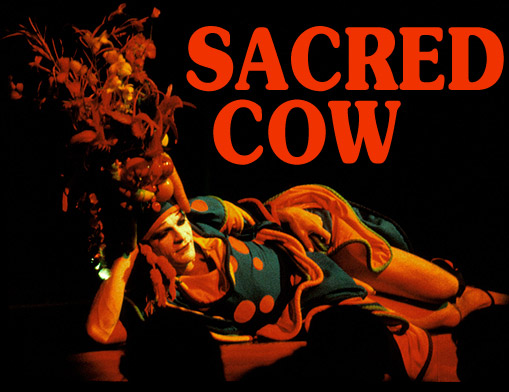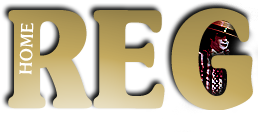
The Glittering Austerity Burlesque!
'Australia's greatest white-faced clown, the inimitable Livermore, sweetheart and bawd, our own Doll Tearsheet of 1979 ... Piaf, Punch, Ariel, Pagliacci and Charlie Chaplin ... the heart of Reg's show is that we are forced to see the self, teeming with life and ransomed with death ... he is everyone's nightmare and everyone's dream ... Thank God for the flying lights, the film clips, the red lame, the bare half moon bum, the gravelly voice, and the hard-edged Wellington Bewts Burlesk Band hidden behind the poor man's Busby Berkerly staircase ...
Part of Reg's brilliance is that spanning the great deserts between then and now, he can do a marvelous send-up of every 1970 pop-star rising out of clouds of theatre smoke at the Sydney Showground, and yet remind us irresistibly of Esther Williams high-diving through clouds of pink and mauve into her celestial swimming pool ... Think back to Feste, Falstaff, Touchstone and his Audrey, Lear's clown, Bottom the ass in Titania's bower, and to Lenny Bruce. 'If the Tiv was still alive Reg would be up there with Mo. They have the same aggression, the same audience participation and identification. We want Reg to win, because he understands the loser in all of us ... He moves across Her Majesty's as if the place was his home, inhabiting the space with such grace, taking charge of it so effortlessly.'
Sacred Cow, Sydney. Extract, Dorothy Hewett's review, Theatre Australia, 1979
While the Wonder Woman season wound up in Melbourne I was already well into preparations for the production of Ned Kelly, the musical I'd been working on with composer Patrick Flynn since the days of Hair. Out of the blue the Adelaide Festival Centre had shown enthusiasm in presenting it and commissioned me to design and direct the show. There was a great deal on my plate and a great deal hanging on the outcome. It was not common practice for a major production arm to bankroll an Australian musical but the $250,000 budget was spent wisely and we achieved a great deal for the then considerable sum one respected radio commentator citing the production for its 'spectacular stagecraft'. In the end Ned Kelly was controversial rather than popular; I came in for a huge amount of flack from all quarters, one of the newspaper hacks going so far as to suggest that 'a rein' should be put on my 'imagination'.
Well that did it. What else sustains us if not our imaginations? I was affronted, and determined that if, as this creep suggested, Australians really were more concerned with mediocrity than quality and adventure I'd give it to them; I'd also decided to let my imagination have a free run, to hell with them all. As you can read, I was pretty het up. That was the genesis of Sacred Cow. The show begins with a Logies like presentation ceremony called the Green Bogeys. Prominently displayed on an ornamental plinth is the coveted trophy, a silver cup filled to overflowing with a repugnant green slime oozing its way slowly down the outside of it like mucous from a running nose. The gala night's host is a much-admired television fixture, Bert Newtown who presents the top honour award to a perfectly ordinary, perfectly dreadful daytime television personality without trace or pretence of talent: Miss Joannie Bigg. Glued to their television sets, mainstream Australia predictably applauds her achievement. The Joannie I created was a monster; I took liberties of performance style enacting her in a grating and pedestrian manner, and perhaps stretching the audience's patience, but if I could get them safely over the first hump I was fairly sure they'd really enjoy others in the parade of characters I had in store for them clearly they recognized my creations and by resorting to that clever conceit audiences often contrive saw all of them as others rather than variations of themselves. Throughout Sacred Cow, the audience is regularly reminded that in this part of the world near enough is bloody good enough.
One of my favourite characters in the piece is Aunty Tom, a sixty years old woman sending well-intentioned condolences via a reel-to-reel tape recording to a sick friend on her last legs in a hospital in Perth, Western Australia. Her complete inability to cope with modern technology is juxtaposed with her fearless grasp of the greater mysteries: life and death. Among others luxuriating in self-stoked delusions of adequacy the audience was introduced to Norma Moore, Senior Cabin Hostess with Air Dingo, Australia's International Carrier; the show's range of musical numbers included Dance Band on The Titanic, and the exquisite and surreal Angie Baby. The finale involves the Everyman figure as Artist, standing in front of a curtain constructed of about 675 electrified hurricane-lamps, blazing bright in the colours and pattern of the Australian flag: a Ned Kelly makeover. I was always sad that more people hadn't had the opportunity to see the wonder of that curtain during the Kelly run and on this occasion it was even more of a sensation. Singing Leo Sayer's Endless Flight, wearing a tattered tailcoat and clutching an about to expire air ticket, the Artist contemplates his available prospects in Australia: there are none. With dreams and hopes as sole baggage, he is preparing to flee forever the easy, the acceptable, and the bloody mediocre. In spite of some anger here and there, it was still a funny night out.
The Sacred Cow staged in Australia was not the one the Brits saw in London in 1980 that prompted the Sydney Daily Telegraph to use its editorial to get well and truly stuck into me. One of the characters I didn't take across to London was the sex-changed and sex-charged Renee Ashfield, International Australian Women's Tennis Champion, whose medical history and confronting centre court antics earn her the condemnation of small-minded local commentators and sports enthusiasts alike. Prophetically, perhaps, Renee was also accused of destroying Australia's good name, and of being a national embarrassment. "Ah, go to buggery!" says Renee, in defence of herself. "WHAT good name? Actually, Australia is a bloody embarrassment to me."
'The British must have a very dim view of the Australian entertainment industry after Reg Livermore's appearance on the London stage. His foulmouthed humour and crude ockerisms had them booing and walking out. Mr Livermore may rely on the language of the gutter to get his comedy across but in doing so he has done other Australian performers a disservice. There was a time when Australian talent was clean and wholesome - and none the poorer for it. Performers such as The Seekers made their name without destroying ours.'
Sydney Daily Telegraph, editorial, 25 August 1980.
As I said, to hell with them.
Photo: Hornpipe


























